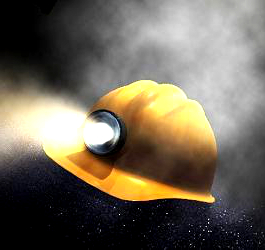Dust exposure re-assessed
 New analysis suggests coal miners are being exposed to more harmful dust than previously believed.
New analysis suggests coal miners are being exposed to more harmful dust than previously believed.
Associate Professor Gunther Paul from James Cook University says scientists have looked at community-based air-monitoring stations in Queensland and New South Wales, along with 10 years of data from the national pollutant inventory, and estimated the impact that coal-mining activity is having on microscopic levels of dust in areas nearby.
The levels of harmful dust particles, metals and nitrogen oxides has increased in line with increases in production, Dr Paul says.
“This increased production of coal produces an increase in pollution, and [that] can be measured in communities — so there is a correlation,” he told reporters.
“We found there is significantly higher PM10 in the mining region compared to south-east Queensland or similar areas in New South Wales.”
PM10 is a classification for particulate matter 10 micrometres or less in diameter.
“Unfortunately, we only have four [air-monitoring] sensors in the coal-mining region, we do need more data in order to better understand how increased coal production and increased production of pollutants eventually impacts the households in the communities,” Dr Paul said.
“We also saw that from those environmental monitoring stations, significant time periods are missing which needed to be filled, so it's very difficult to provide a coherent picture at this time, and we do need more measurements.”
The Hunter Valley in NSW is the largest producer of PM10 emissions from coal, according to the experts, which four postcodes in Queensland's Central Highlands form the rest of the top five.
Stephen Smyth from the CFMEU says the exposure limit for miners — 2.5µg/m³ (per cubic metre of air) — should be reduce to 1.5µg/m³, in line with the National Institute for Occupational Safety and Health.
“If you're increasing someone's exposure to dust and the control measures are ineffective, then you increase that person's risk of getting a mine-dust lung disease,” he said.
“A person goes to work, comes home and can be living close by, and they can continue to get some sort of level of dust exposure.”
Dr Paul says there should be a change in legislation too.
“So there is some understanding that the occupational exposure limit may be too high in Australia and we would like to understand which other factors impact on this exposure limit,” he said.
“If there is additional exposure of miners in the communities where they live, then that indicates the exposure limit will have to be corrected and will have to be set lower.
“It's likely that we need to change regulations and possibly include environmental exposure to be one factor that contributes to the assessment of risk for workers and how much they are permitted to be exposed to coal dust.
“The occupational exposure limit is based on an eight-hour work shift; if workers work more than 40 hours a week, then the occupational exposure limit is currently reduced to 2.35µg/m³.
“In a very similar way, we could make assumptions about where workers live and then consider the environmental exposure in order to further reduce the occupational exposure limit.
“This would have to be considered in amended regulations and standards and would have to go through the legal processes.”
Queensland Resources Council chief executive Ian Macfarlane - who was federal industry minister in the Howard and Abbott governments - says the health of workers and communities is the industry's top priority.
“Exposure to particulates is continuously monitored and regularly reviewed by industry and the State Government,” he said.
“The resources sector in Queensland operates and monitors emissions within the strict conditions of each company's environment authority and air quality legislation to protect the environment and human health.”







 Print
Print